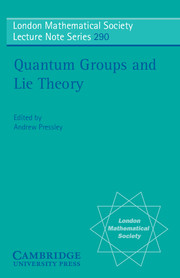Book contents
- Frontmatter
- Contents
- Introduction
- Lectures on Cyclotomic Hecke Algebras
- An Introduction to Group Doublecross Products and Some Uses
- Canonical Bases and Piecewise-linear Combinatorics
- Integrable and Weyl Modules for Quantum Affine sl2
- Notes on Balanced Categories and Hopf Algebras
- Lectures on the dynamical Yang-Baxter Equations
- Quantized Primitive Ideal Spaces as Quotients of Affine Algebraic Varietie
- Representations of Semisimple Lie Algebras in Positive Characteristic and Quantum Groups at Roots of Unity
- The Yang-Baxter Equation for Operators on Function Fields
- Noncommutative Differential Geometry and Twisting of Quantum Groups
- Finite Quantum Groups and Pointed Hopf Algebras
- On Some Two Parameter Quantum and Jordanian Deformations, and their Coloured Extensions
- Tensor Categories and Braid Representations
Lectures on Cyclotomic Hecke Algebras
Published online by Cambridge University Press: 05 November 2009
- Frontmatter
- Contents
- Introduction
- Lectures on Cyclotomic Hecke Algebras
- An Introduction to Group Doublecross Products and Some Uses
- Canonical Bases and Piecewise-linear Combinatorics
- Integrable and Weyl Modules for Quantum Affine sl2
- Notes on Balanced Categories and Hopf Algebras
- Lectures on the dynamical Yang-Baxter Equations
- Quantized Primitive Ideal Spaces as Quotients of Affine Algebraic Varietie
- Representations of Semisimple Lie Algebras in Positive Characteristic and Quantum Groups at Roots of Unity
- The Yang-Baxter Equation for Operators on Function Fields
- Noncommutative Differential Geometry and Twisting of Quantum Groups
- Finite Quantum Groups and Pointed Hopf Algebras
- On Some Two Parameter Quantum and Jordanian Deformations, and their Coloured Extensions
- Tensor Categories and Braid Representations
Summary
Introduction
The purpose of these lectures is to introduce the audience to the theory of cyclotomic Hecke algebras of type G(m, 1, n). These algebras were introduced by the author and Koike, Broué and Malle independently. As is well known, group rings of Weyl groups allow certain deformation. It is true for Coxeter groups, which are generalization of Weyl groups. These algebras are now known as (Iwahori) Hecke algebras.
Less studied is its generalization to complex reflection groups. As I will explain later, this generalization is not artificial. The deformation of the group ring of the complex reflection group of type G(m, 1, n) is particularly successful. The theory uses many aspects of very modern development of mathematics: Lusztig and Ginzburg's geometric treatment of affine Hecke algebras, Lusztig's theory of canonical bases, Kashiwara's theory of global and crystal bases, and the theory of Fock spaces which arises from the study of solvable lattice models in Kyoto school.
This language of Fock spaces is crucial in the theory of cyclotomic Hecke algebras. I would like to mention a little bit of history about Fock spaces in the context of representation theoretic study of solvable lattice models. For level one Fock spaces, it has origin in Hayashi's work. The Fock space we use is due to Misra and Miwa. For higher levelFock spaces, they appeared in work of Jimbo, Misra, Miwa and Okado, and Takemura and Uglov.
Information
- Type
- Chapter
- Information
- Quantum Groups and Lie Theory , pp. 1 - 22Publisher: Cambridge University PressPrint publication year: 2002
Accessibility standard: Unknown
Why this information is here
This section outlines the accessibility features of this content - including support for screen readers, full keyboard navigation and high-contrast display options. This may not be relevant for you.Accessibility Information
- 4
- Cited by
